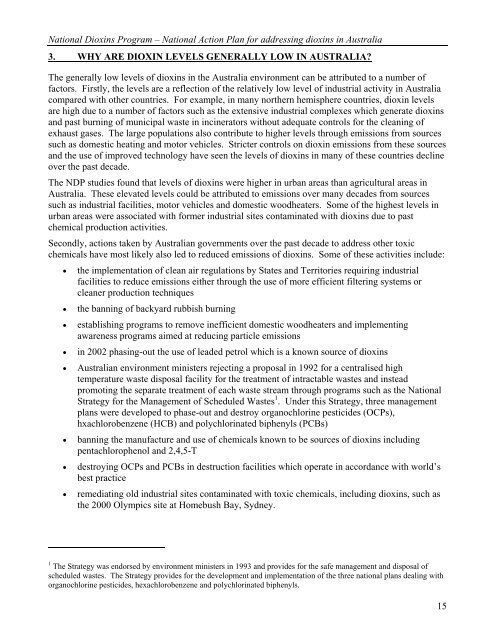National Action Plan for Addressing Dioxins in Australia
National Action Plan for Addressing Dioxins in Australia
National Action Plan for Addressing Dioxins in Australia
- No tags were found...
You also want an ePaper? Increase the reach of your titles
YUMPU automatically turns print PDFs into web optimized ePapers that Google loves.
<strong>National</strong> <strong>Diox<strong>in</strong>s</strong> Program – <strong>National</strong> <strong>Action</strong> <strong>Plan</strong> <strong>for</strong> address<strong>in</strong>g diox<strong>in</strong>s <strong>in</strong> <strong>Australia</strong>3. WHY ARE DIOXIN LEVELS GENERALLY LOW IN AUSTRALIA?The generally low levels of diox<strong>in</strong>s <strong>in</strong> the <strong>Australia</strong> environment can be attributed to a number offactors. Firstly, the levels are a reflection of the relatively low level of <strong>in</strong>dustrial activity <strong>in</strong> <strong>Australia</strong>compared with other countries. For example, <strong>in</strong> many northern hemisphere countries, diox<strong>in</strong> levelsare high due to a number of factors such as the extensive <strong>in</strong>dustrial complexes which generate diox<strong>in</strong>sand past burn<strong>in</strong>g of municipal waste <strong>in</strong> <strong>in</strong>c<strong>in</strong>erators without adequate controls <strong>for</strong> the clean<strong>in</strong>g ofexhaust gases. The large populations also contribute to higher levels through emissions from sourcessuch as domestic heat<strong>in</strong>g and motor vehicles. Stricter controls on diox<strong>in</strong> emissions from these sourcesand the use of improved technology have seen the levels of diox<strong>in</strong>s <strong>in</strong> many of these countries decl<strong>in</strong>eover the past decade.The NDP studies found that levels of diox<strong>in</strong>s were higher <strong>in</strong> urban areas than agricultural areas <strong>in</strong><strong>Australia</strong>. These elevated levels could be attributed to emissions over many decades from sourcessuch as <strong>in</strong>dustrial facilities, motor vehicles and domestic woodheaters. Some of the highest levels <strong>in</strong>urban areas were associated with <strong>for</strong>mer <strong>in</strong>dustrial sites contam<strong>in</strong>ated with diox<strong>in</strong>s due to pastchemical production activities.Secondly, actions taken by <strong>Australia</strong>n governments over the past decade to address other toxicchemicals have most likely also led to reduced emissions of diox<strong>in</strong>s. Some of these activities <strong>in</strong>clude:• the implementation of clean air regulations by States and Territories requir<strong>in</strong>g <strong>in</strong>dustrialfacilities to reduce emissions either through the use of more efficient filter<strong>in</strong>g systems orcleaner production techniques• the bann<strong>in</strong>g of backyard rubbish burn<strong>in</strong>g• establish<strong>in</strong>g programs to remove <strong>in</strong>efficient domestic woodheaters and implement<strong>in</strong>gawareness programs aimed at reduc<strong>in</strong>g particle emissions• <strong>in</strong> 2002 phas<strong>in</strong>g-out the use of leaded petrol which is a known source of diox<strong>in</strong>s• <strong>Australia</strong>n environment m<strong>in</strong>isters reject<strong>in</strong>g a proposal <strong>in</strong> 1992 <strong>for</strong> a centralised hightemperature waste disposal facility <strong>for</strong> the treatment of <strong>in</strong>tractable wastes and <strong>in</strong>steadpromot<strong>in</strong>g the separate treatment of each waste stream through programs such as the <strong>National</strong>Strategy <strong>for</strong> the Management of Scheduled Wastes 1 . Under this Strategy, three managementplans were developed to phase-out and destroy organochlor<strong>in</strong>e pesticides (OCPs),hxachlorobenzene (HCB) and polychlor<strong>in</strong>ated biphenyls (PCBs)• bann<strong>in</strong>g the manufacture and use of chemicals known to be sources of diox<strong>in</strong>s <strong>in</strong>clud<strong>in</strong>gpentachlorophenol and 2,4,5-T• destroy<strong>in</strong>g OCPs and PCBs <strong>in</strong> destruction facilities which operate <strong>in</strong> accordance with world’sbest practice• remediat<strong>in</strong>g old <strong>in</strong>dustrial sites contam<strong>in</strong>ated with toxic chemicals, <strong>in</strong>clud<strong>in</strong>g diox<strong>in</strong>s, such asthe 2000 Olympics site at Homebush Bay, Sydney.1 The Strategy was endorsed by environment m<strong>in</strong>isters <strong>in</strong> 1993 and provides <strong>for</strong> the safe management and disposal ofscheduled wastes. The Strategy provides <strong>for</strong> the development and implementation of the three national plans deal<strong>in</strong>g withorganochlor<strong>in</strong>e pesticides, hexachlorobenzene and polychlor<strong>in</strong>ated biphenyls.15
















